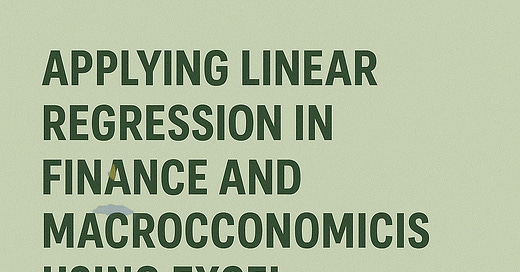Applying Linear Regression in Finance and Macroeconomics Using Excel: A Step-by-Step Guide with Real-World Analysis
Article Outline:
Introduction
Importance of data analysis in finance and macroeconomics
Role of linear regression in identifying economic and financial relationships
Why Excel is a valuable tool for analysts and students alike
Understanding Linear Regression in Financial and Economic Context
What is linear regression?
Core components: dependent variable, independent variable, slope, intercept, R²
Examples of real-world applications:
Predicting stock returns based on interest rates
Estimating inflation based on money supply
Analysing GDP growth relative to investment
Setting Up the Problem: GDP Growth vs Investment Rate
Defining the economic question: Does higher investment lead to higher GDP growth?
Description of variables:
Independent Variable: Investment as a % of GDP
Dependent Variable: GDP Growth Rate (%)
Creating the Dataset in Excel
Entering time-series or cross-sectional data into Excel
Organising columns for economic indicators
Brief overview of where such data typically comes from (e.g., World Bank, IMF)
Visualising the Relationship
Creating a scatter plot in Excel
Adding axis labels and titles
Initial observations on correlation
Performing Linear Regression in Excel
Adding a trendline and displaying the regression equation and R²
Using the LINEST function for detailed output
Explanation of slope, intercept, and what R² tells us
Interpreting Results in Economic Terms
Meaning of the slope in context: how much GDP growth changes with a 1% change in investment
Practical insights for policymakers and analysts
Discussing model limitations
Forecasting and Scenario Analysis
Using the regression model to predict GDP growth under different investment scenarios
Implementing formulas to automate predictions
Highlighting the potential for policy simulation
Conclusion
Recap of the analytical steps
Importance of statistical tools in understanding economic dynamics
Encouragement to explore further applications in finance and macroeconomics
This article demonstrates how to use linear regression in Excel to analyse and interpret economic relationships—such as the effect of investment on GDP growth—providing practical skills for evidence-based financial and policy analysis.
Keep reading with a 7-day free trial
Subscribe to AI, Analytics & Data Science: Towards Analytics Specialist to keep reading this post and get 7 days of free access to the full post archives.




